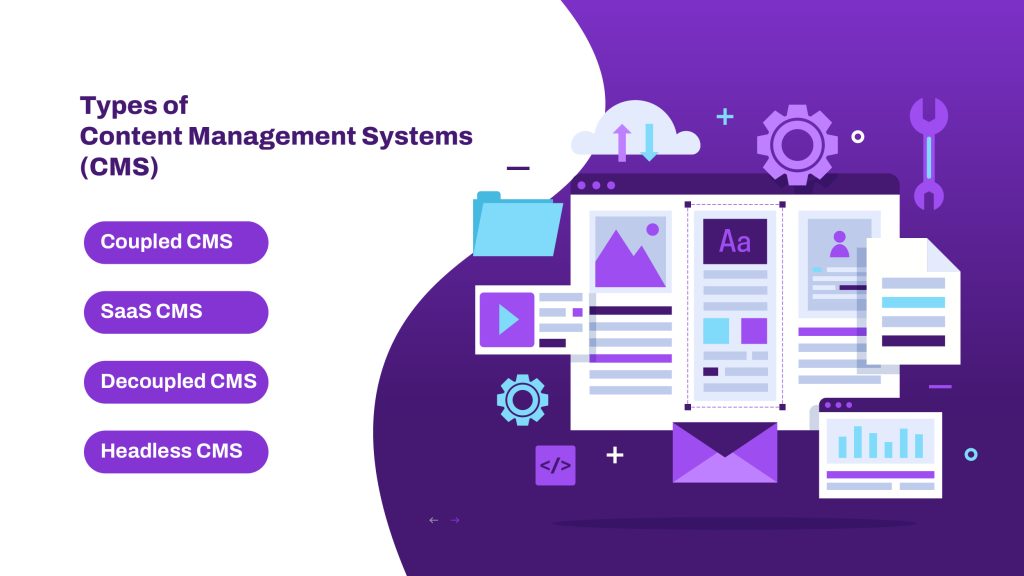Content management refers to the process of organizing, storing, and distributing digital content, such as text, images, and videos, in a structured and efficient way. This includes the creation, publication, and maintenance of content, as well as ensuring its accuracy and relevance over time. Effective content management is crucial for businesses to maintain a strong online presence and engage with their target audience.
Typically, content management software is built expressly for managing digital content. There are numerous kinds of content management systems (CMS) available to satisfy the requirements of customers in numerous different industries. Throughout the information lifecycle, CMS facilitates collaboration and streamlines workflow procedures for both individuals and companies.
There is a management tool for every type of digital content. Social media content, web content, mobile content, and business content are examples of these sorts of content (also in the form of data).
What is content management?
The process of developing, gathering, modifying, and providing any kind of information on any channel is referred to as content management. Content can include anything, including text, photos, music, video, and multimedia. Every piece of content has a lifecycle that must be handled, starting with creation and ending with storage or deletion.
In various companies and sectors, content management is known by different names and has distinct aims. Nonetheless, it is always a cooperative process meant to manage and oversee the various iterations of a piece of material as it develops from its preliminary to its final edition. Managing a website’s digital assets and preserving corporate papers including branding standards, business plans, communications, and more are both examples of content management.
For instance, WordPress is a content management system used by 43.2% of all websites.
In industries with special reporting needs, such as healthcare, government contracting, and others, content resource management is a top responsibility. Also, it is helpful in the industrial sector, where accurate user manuals and help documentation are an essential component of total quality control, and in the financial sector, where transparency is crucial.
Bigger firms have more complicated content management requirements, whether they involve enhancing communication across several business units or managing a number of regional websites with shared resources.
The ideal kind of content management system for your company will depend on its needs. Understanding the various possibilities on the market at the moment is the first step in making the best decision.
Types of content management systems (CMS)
Tens of millions of individuals utilize CMS systems. Since there are currently over 73 million CMS websites online, there would be between 36 and 73 million users even if each user only created one to two websites.
The front end and the back end of a CMS are the two main components. The user interacts with the front end of the system. It has to do with how websites are clearly formatted and organized. In order to present rich, interactive content that is styled to go with your company’s branding, the front end combines HTML, CSS, and JavaScript.

The program used to add new content to a website is known as the back end of a CMS. Using a web interface to quickly add, create, and publish content to your CMS’s front end is the first step in the procedure. Instead of understanding HTML, CSS, and JavaScript, you generate content in a Microsoft Word-like interface. After being published to the front end of the website, the back end stores this material in the database.
The CMS is made up of these two systems when combined. You can publish material using them without having to construct your online application from scratch or comprehend web technology.
Below are a few examples of the various kinds of content management systems that are now accessible.
Coupled CMS
A classical CMS is another name for a connected CMS. It provides a fully functional back end that connects to, edits and publishes material to a front end with a stylized appearance.
The fundamental difference between a connected CMS and a software-as-a-service (SaaS) CMS is that a coupled CMS needs dedicated web hosting to function, even though it is an all-in-one solution. Although web hosting is often affordable, it’s crucial to keep in mind that a CMS needs certain technologies installed and maintained in order for the program to function.
Furthermore, an administrator will probably be needed to set up and configure the system installation for continued use in a coupled CMS. WordPress is an illustration of a linked CMS because it provides customers with a whole package to install, deploy, and publish content in the future.
SaaS CMS
Although a SaaS CMS is also an entire, end-to-end solution, a linked CMS is hosted on-premises. This indicates that it doesn’t need to be set up, installed, or configured for web hosting.
For businesses that need a simple web presence, a SaaS-based CMS is a great option because it provides all the features without any server or web-hosting overhead. It makes it possible for users of all types to swiftly build websites, manage information, and share it via online channels.
Decoupled CMS
The presentation portion of the website is “decoupled” from the back end in a decoupled CMS. The delivery system is located between the website’s presentation and the back end, and it is accessed via an API (API).
An advanced option that provides more flexibility to interact with the content created in the back end is a decoupled content management system (CMS). Assume, for instance, that a company wishes to leverage the information in its library for a brand-new endeavor, like mobile apps. A decoupled CMS is a good option in this situation since it supports a variety of flexible front-end applications while maintaining consistent back-end data and content.
Headless CMS
A front-end web application that was specifically created for a headless CMS has only a back-end system that accesses a database and stores content. It is more flexible than a decoupled CMS, but it also takes a lot more effort than any alternative. Moreover, a front-end application must typically be designed, built, and connected using a headless CMS.
For businesses that require total control and flexibility over how their material is accessible, a headless CMS is a suitable option. It offers content categorization and storage while enabling a unique front-end application, such as a website, a mobile app, or another front-end.
What are content management best practices?
Avoiding the creation of content silos is one excellent practice. Consistency issues arise when businesses use several teams to provide content for various channels.
The business must ensure that the other teams modify their content as needed if one team modifies it. This might make everything take longer. Hence, centralizing content development is a best practice. To maximize efficiency, content should be created by a single team and then published to various channels.
On different devices, the content will appear differently. But, if one team is in charge of managing the material for both channels and the business has to make a change, it won’t be necessary to approach two different teams for approval. They simply need to alert one team, and that team will ensure that the modifications are implemented simultaneously across all channels.
Having tools for content analysis and personalization is another best practice. A lot of businesses don’t regularly monitor how that content is functioning or aggressively personalize it. The objective is to convert clients; simply delivering material is not sufficient. Customers who are shown content they are not interested in will not convert.
A corporation must have the proper tracking tools in place before delivering content so that it may be customized for customers using various locations or devices.
To Sum It Up
No matter the category, business, or organization, most CMS have several elements in common. These functions center on turning points in the content lifecycle into bottleneck-free workflows. The best content management systems (CMS) support organizations at every stage of the content lifecycle, from format management to version control and publishing functionalities.
